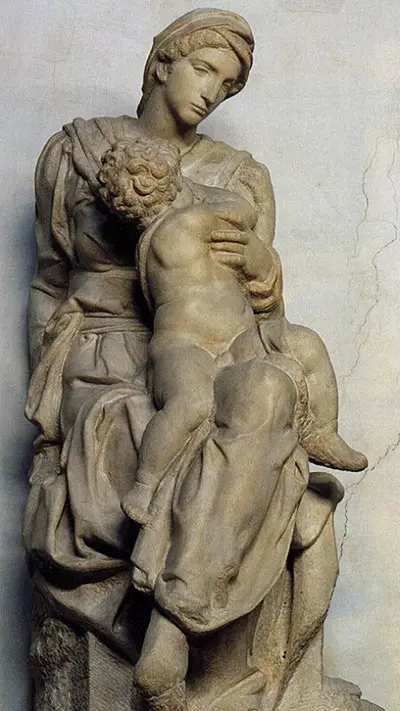The sculpture was originally part of the Medici tombs, and it rests over the tomb of Lorenzo the Magnificent. It stood between the statues of Cosmas and Damian, the patron saints of Medici. Currently, the piece sits at the altar of the Sagrestia Nuova at the San Lorenzo Basilica.
Michelangelo was obsessed with the Virgin Mary and child theme as is evident in most of his works, and this Madonna is no different. The sculpture is of the Virgin holding the baby Jesus. In this marble representation, the child’s face is away from the spectator, buried in the Virgin’s bosom, searching for his mother’s breast.
From his demeanour, the child appears restless. The mother has her left hand holding the baby effortlessly while the other hand is behind her, grabbing the seat. From the way Madonna is sitting, she is not looking to give the child what he wants. Her legs are crossed over each other and then there is her dress, which covers her from neck to ankle.
The expression of Madonna on this sculpture is hard to miss. As the child fidgets on her lap, she tilts her head slightly and has a thoughtful look upon her. She almost looks sorrowful, perhaps as she contemplates the fate that awaits her son, Christ.
The facial features may not be quite as refined as in Michelangelo’s Pieta, but they are distinct, considering the sculpture is unfinished. Granted that there is no smiling Madonna in Michelangelo’s works, but this one seems apprehensive, almost as if she can tell bad things are about to happen. Michelangelo carved the child with a herculean stature that is hard to ignore, particularly since he is still in his mother’s laps.
The baby’s body shows strength, which may depict the role that he will grow to play as the saviour of humankind. Madonna’s hold on the baby is not protective as if in agreement that he is old enough to let go. The sculpture also paints a clear picture of Mary taking care of a baby that is bigger than humankind, including herself.
Michelangelo was still working on the piece in 1534 in his Florentine studio when he had to move to Rome, so it remained incomplete. Its rough edges, and lack of polishing add to the charm of the artwork.
The smooth contours of the baby’s muscles contrast with the almost rugged hem of Mary’s drapery. His curly head of hair rests just above his mother’s breast, which acts as a cushion. This part of the sculpture is what brings out the connection between mother and child. Spectators cannot fail to see the contrast of Christ’s naked body lying on Mary’s long dress.
Michelangelo's childhood emotionally motivated his portrayal of Mother Mary. Through personal writing, poetry and letters from the Renaissance sculptor, it is revealed that he had a deep connection with his wet nurse. He seemed to have been relating his wet nurse to every single Madonna he ever made.
The Medici Chapels
Cardinal Giulio de Medici commissioned the Medici Madonna with support from Pope Leo X, his brother. The Medici dynasty commissioned several works for the Basilica de San Lorenzo, including Florentine architect, Brunelleschi.
Michelangelo joined the project to work on the tombs of Giuliano and Lorenzo de Medici. The Medici family was one of the most influential in the growth of Italian Renaissance art. Their patronage of the arts was epitomised through the Medici chapels, which were initially meant to be the resting place of Medici family members. The Medici Madonna, which symbolises life, is a unique setting between the tombs of the two Medici dukes.
Michelangelo Buonarroti
Michelangelo influenced western art in significant ways through his sculptures, poetry and paintings. The Italian artist, undoubtedly, one of the greatest of all time, made a name a true Renaissance man due to his versatile work. Michelangelo has some of the most prominent artwork in history, most notably David and the Pieta; he did these two pieces before he was thirty.
The Statue of David, completed in 1504, established Michelangelo’s skills and made him a sought-after name in the art world. David is the most famous male nude sculpture anywhere, and it set precedence for other sculptors, some of whom have reproduced it all over the world.
Being an architect, Pope Julius II commissioned Michelangelo to build the Pope’s tombs, which took 40 years. It is during this period that Michelangelo did another grand project, the painting of the Sistine Chapel ceiling, which took four years.
The painting of the Sistine Chapel tells several stories from the Book of Genesis and its complexity wows artists to this day. Many Baroque ceiling painters derive inspiration from this piece, which was hailed to ‘restore light in a world that was plunged into darkness.’
Leonardo da Vinci and Raphael (Raffaello Sanzio) are two names that are always mentioned with Michelangelo when talking about the Florentine High Renaissance. However, Michelangelo lived a reclusive life, so he did not have many acquaintances.
Francesco Granacci, a fellow student at the Medici Academy and an assistant with the Sistine Chapel painting, was one of the few who were employed by Michelangelo.
Raphael is one of the artists who were directly influenced by the Michelangelo Buonarroti. Some of his works are imitations of Michelangelo’s prophets. Pontormo, Rodin and Henry Moore are others who gained inspiration from Michelangelo.



